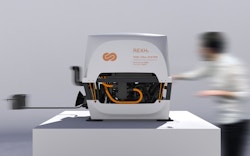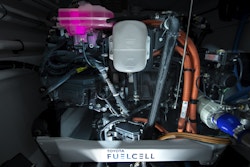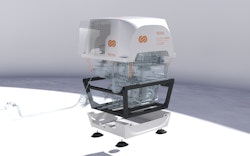The challenges of the REXH2
While the crew of Energy Observer continues to navigate the Atlantic without being able to set foot on land, another team is holding its breath: that of Energy Observer Developments (EODev), whose REXH2 is currently sailing on the first hydrogen vessel around the world.

World Premieres
In 2017, the first hydrogen-fueled "marine" fuel cell was installed in France on board Energy Observer, for a series of stopovers, in France, then in Europe, thus leading our autonomous ship to the Arctic Circle in 2019. During this trip, Energy Observer was equipped with a fuel cell, developing a power of 30kW, designed in collaboration with the CEA. Although it is still on board and has fulfilled its role wonderfully during these first couple of years, the energy needs of the ship kept increasing as new technologies were installed to be tested and as the navigation periods extended.

The Toyota Fuel Cell system onboard Energy Observer
This observation, combined with the opportunities offered by the capacities of the new Toyota batteries, which were more powerful, lighter, and more compact, led the team of Energy Observer to initiate talks with the Japanese manufacturer to use their technology to improve energy autonomy at sea. The result of the fruitful collaboration between Toyota and EOdev engineers was the birth of our REXH2, i.e. Range EXtender H2, whose primary goal is, as its name suggests, to increase the energy autonomy of a ship, whether the energy produced is used for propulsion, on-board systems, or both.
After spending many months on Toyota’s test bench in Belgium, in its test version, the first REXH2 was finally installed on board Energy Observer where is was tested again and again over the winter to ensure its reliability as well as its performance in a demanding marine environment, subject to many changing weather patterns, waves, swell and roll. The ocean is a roller coaster, not a highway; and a fuel cell is a sensitive organ, which must be protected from any external dust and harmful particles. In February 2020 it was ready to be implemented for its first transatlantic crossing, but was unfortunately delayed a few times as a result of capricious weather conditions across the Atlantic.
It may be difficult to imagine what this trip means, or to realize the extent of advances brought about by the installation of the REXH2 on board Energy Observer. So to understand it, one must bear in mind that until now no fuel cell, whatever its size or power, not to mention its cost, had ever crossed any ocean in a single trip, with no possibility of being refueled, maintained, or fixed. When driving a Toyota Mirai, a hybrid car or even a Tesla, you are on solid ground. If you run out of fuel, you can walk and find a place to recharge, or call Engie to deliver hydrogen. None of this is possible in the middle of the Atlantic, whereas in this hostile environment, the risks of breakdown can be multiplied over and over.
The bet was all the more daring as the adventure was attempted with a new fuel cell, rather than simply relying on the capacities of the previous one, which would not have been enough to guarantee the autonomy required for such a crossing anyway, especially as the Pacific crossing is also looming in the distance.
Cutting-edge Technologies and Pragmatism
The transition from a 30kW battery to the new 80kW fuel cell (60kW continuous) has not only doubled the capacities of the vessel, it has increased them exponentially. Indeed, it is important to understand that a REXH2 is, like the Toyota Mirai, designed to operate in conjunction with one or more batteries. Although it is theoretically possible to ensure the propulsion of a small boat, having a simple and recurrent user profile, with the electricity supplied by a single fuel cell, it is more pragmatic to couple it with batteries which will serve both as an energy reserve (storage) and as an energy source for the propulsion and the hotel load.
The benefits, compared to an "all-electric" scheme, is to reduce the need for a large number of batteries, whose sustainability and recycling possibilities are questionable, while allowing a substantial weight gain for more or less the same volume. It is also a cheaper solution in terms of acquisition price / buying price and operational costs In addition, up to 10 REXH2 can be combined so as to bring the power of the system from 80 to 800kW. Finally, the hydrogen fueling it can be completely "green", when resulting from water electrolysis, whereas a battery is usually recharged via "the grid", whose energy is not always of virtuous origin.
The REXH2, in electric hybridization, or even in diesel-hydrogen-electric hybridization, appears today as the option most likely to reduce as much as possible CO2 and fine particle emissions on board ships; at least until, thanks to the future improvement of green hydrogen production and storage capacities, it will finally be possible to run entirely on hydrogen to meet all of the on-board energy needs.

Hydrogen for All
“We are happy to be able to market these products, which are real lasting solutions for the preservation of the environment, without losing sight of efficiency and progress. This is just the beginning, but I want to thank and congratulate our engineers as well as the teams alongside. Whether it's our staff, our financial supporters, and our shareholders, who are very committed to the energy transition, or whether it is through strong technological partnerships like the one established with Toyota. Making boats silent and zero emissions at an affordable price is also a great opportunity to accelerate the virtuous development of the hydrogen society, as it will result in the consumption of several hundred kilograms of hydrogen per day, which favors the multiplication of distribution points and the consumption of hydrogen that is good for the environment.”
Enabling the industrialization of the hydrogen solutions developed by its engineers using the Toyota fuel cell technology is now the primary objective of EODev, both as an incubator and accelerator for the expansion of the hydrogen society. Although the REXH2 is a milestone / an important step, other solutions will soon be available to the public.
Once the Atlantic crossing is completed, the next step will be the launch in September 2020 of the first hydrogen tender equipped with the same fuel cell, a 12-meter boat resulting from the collaboration between EODev and a shipyard in the south of France. The objective is to provide environmentally conscious shipowners wishing to access protected natural areas by boat, with a range of sustainable, quietly powered, emission-free and quickly refueled pleasure boats at a relatively affordable cost compared to existing solutions.
The REXH2 will then also be integrated into different kinds of ships, from pleasure yachts to professional boats, and passenger shuttles, in full compliance with environmental and regulatory constraints.